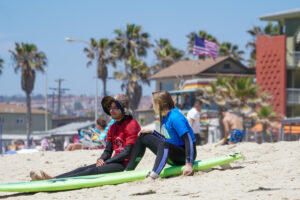Surf wax is important to any surfer. After all, it’s what prevents you from slipping and falling off of your board. It’s the surf wax that provides traction and grip on the board, without which all of the surf lessons in San Diego wouldn’t help you catch a wave. Knowing how to apply surf wax in the right way could make the difference between catching the wave of your dreams or experiencing a heart-breaking wipeout.
The first thing you should learn about wax as a part of your San Diego surf lessons is the difference between the distinct grades of surf wax. There are four grades and each one is best suited for different climates. The grades are: basecoat, which is the hardest wax that is initially places on the board and is in some cases the only wax that doesn’t melt; tropical, which is best suited for water that is 75 degrees and warmer; warm, which is ideal for water between 64 and 74 degrees; cool, which is best in water between 58 and 58 degrees; and cold, which is suitable for water below 60 degrees.
When applying the wax you begin with the basecoat which should always be applied in the shade. On a short board you apply the wax from edge to edge on the top side of the board starting at the logo and moving all the way back to the back edge. On a longboard you apply the wax from edge to edge on the top side covering the entire board from the nose to the tail.
There are a few options in how you apply the wax. You can apply it using a circular pattern while moving up and down the boars. Another option is a straight line pattern moving up ad down the board parallel to the rocker. A third option is the crosshatch pattern in which you first rub it on in diagonal lines, then repeat in another diagonal that creates the crosshatch. Whichever way you choose you should continue, using the edge of the stick of wax, until small bumps appear along the board. These are the bumps that will provide traction, so make sure they are there.
After the basecoat has been applied you are ready to apply the temperature specific wax. Rub the temperature wax across the entire area of the basecoat. Sometimes it is helpful to use a different colored temperature wax to make sure you cover the entire basecoat.
Once the temperature wax is applied, it is time to use the wax comb. Run the comb over the wax in diagonal lines, creating a crosshatch. By roughing up the wax you are creating even more traction on the surface of your board. You will need to comb the wax to create better grip every time you go out to surf at your San Diego surf school.
Now you are ready to paddle out, so sign up for some surf lessons in San Diego by calling Pacific Surf at (858) 488-2685.
Photo by Filios Sazeides on Unsplash




